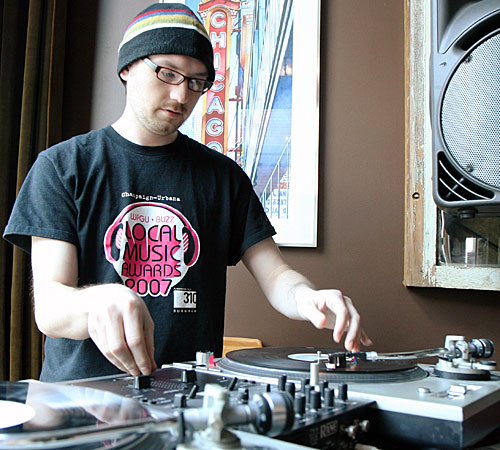Local DJ teaches scratching basics

DJ Bozak of Champaign demonstrates how to scratch at Boltini Lounge in downtown Champaign on Monday. Erica Magda
Apr 23, 2008
Last updated on May 13, 2016 at 10:12 a.m.
Records may be a format of the past, but they haven’t disappeared from use the way cassette tapes have. DJs often use them despite the rising popularity of iTunes and digital files. There are just some things you can’t do with an mp3, including good old-fashioned scratching.
DJ Bozak, also known as Adam Boskey, said he taught himself to scratch in the summer of 1996.
He entered the local DJ battle scene that year. He started DJing on the radio in 1998 and in clubs in 1999. Bozak, 29, graduated from the University in 2003 and currently DJs at Boltini Lounge on Thursdays, Barfly on Fridays and Soma Ultralounge on Saturdays. Bozak showed me the basic ins and outs of scratching Monday afternoon at Boltini Lounge, 211 N. Neil St., Champaign.
What You Need
“You need something to play the sound, the turntable; you need something that will allow you to cut it out (the mixer),” Bozak said.
You also need records, needles and either speakers or headphones. Bozak said turntables cost about $400 or $500; a mixer can cost $650; the needles cost about $100 each and the records he used were about $12 and $6 respectively.
“It’s not cheap, but you put your money where your passions are,” he said.
He stressed that knowing the fundamentals of scratching is more important than what brand is being used.
“The theory behind what you’re doing (matters), it doesn’t matter what brand you use,” Bozak said. “Although, the better the piece, the more precise the motor is; the better equipment you learn on, you get better faster. Although, most of the DJs that started all of this were on crappy, crappy stuff.”
How To Start
“I just think of it in real simple terms – you can let a sound play; you can not let it play; you can then modulate it in some way,” Bozak said. “There are different ways of modulating a sound. Really, to me, that’s the main concept. It’s just combinations of letting it play, modulating it – which would be, you know, augmenting it in some capacity and not letting it play.”
The mixer allows you to control what is playing and what is silenced. Any record can be used to scratch, although Bozak said he only uses one record to scratch right now. “Scratchy Seal Breaks” by DJ Q-Bert is a record of sounds made specifically for scratching.
“This one is particular for that task because it doesn’t skip,” Bozak said. “The way the sounds are lined up, if I were to pull up the needle and put it down it’s the same sound. So if the needle skips, it’s right there.”
The record also contains what Bozak said are the two most popular scratching sounds: the “fresh” and someone saying “ah” through a vocoder.
He compared the use of these two sounds for DJing to the idea of jazz standards.
“With DJing, scratch DJing in particular, it’s what can you do with (the ‘ah’) and what can you do with the ‘fresh,'” Bozak said.
Types Of Scratches
“There’s some basic foundation things that working on will improve your dexterity and get you faster and what not,” Bozak said. “Those are based on those basic principles (letting sound play, not letting it play, modulating it).”
The Baby Scratch: moving the record in a back and forth motion.
Forward: “Just letting it play and you’re turning off the backspin, it’s like half of the baby,” Bozak said.
The Transformer: using the fader to cut the sound in and out.
The Flare: the opposite of the transformer.
“Once you get comfortable with your hands on the material and it’s like muscle memory, like going forward just happens when you think it, then you can get to a point where you’re actually creating the sounds,” Bozak said.
This is why it is important to have the fundamentals down. Bozak said he used to teach DJ lessons and would have people practice the baby scratch all day or practice the forward scratch to a beat.
“It sucks (to practice forward scratches or baby scratches all day), but that’s really the best way to learn,” Bozak said. “That’s how I learned. When you get tight and precise like that, then you move on to combining things.”
Bozak said he prefers to stick to what he wants to do rather than pay attention to what other people are doing or what types of scratches are gaining popularity.
“I actually like to not keep track of everything because then I feel a little more free with it,” Bozak said. “Like oh, DJ Precise is doing prisms so I need to know prisms. I just think of sounds in my head and then I try to replicate them.”
The Equipment
This lesson happened on Boltini’s equipment, with the exception of the needles and the records, which were Bozak’s. DJs usually bring their own needles to a club because of wear and tear.
Turntables: Technics Quartz Direct Drive Turntable System SL-1200M3D
Mixer: Rane TTM56 Performance mixer
Needle cartridges: Shure M44-7




 DI multimedia
DI multimedia

